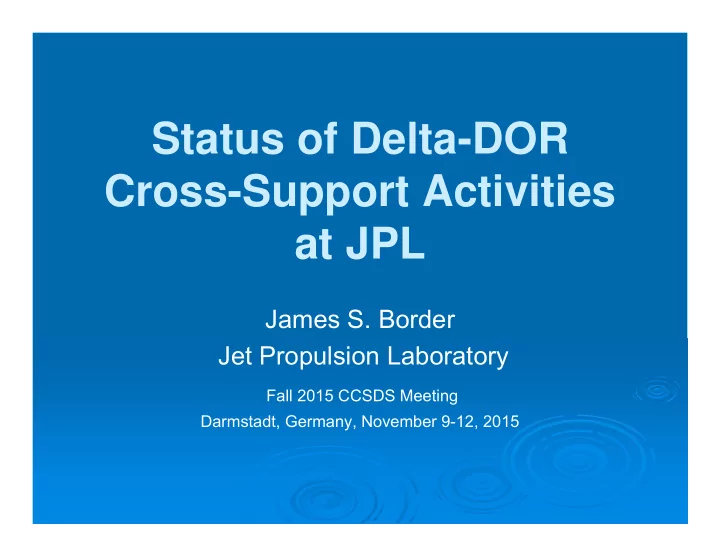

Status of Delta-DOR Cross-Support Activities at JPL James S. Border Jet Propulsion Laboratory Fall 2015 CCSDS Meeting Darmstadt, Germany, November 9-12, 2015
Jet Propulsion Laboratory California Institute of Technology Current Cross-Support Activity - 1 JPL/ESA are conducting radio source catalog measurements with Malargue and NASA/DSN stations At JPL, this work is managed by Radio Source Catalog Group Frequency band is Ka (would like X/Ka) Provides unique southern hemisphere coverage for catalog Good Results; Ka Catalog will soon replace S/X Catalog JPL 810-005 Quasar Catalog is updated ~ 2 years X-band Catalog was updated in 2014 Ka-band Catalog to be delivered in 2016 (?) JPL InSight mission to Mars in 2016 has a low southern declination trajectory Only visible from one DSN baseline for ∆ DOR • Flight Path Angle depends on the orthogonal direction NASA requested cross-support from both ESA and JAXA Both ESA and JAXA have agreed to provide ∆ DOR cross-support • Tracking schedules now being negotiated 2 CCSDS Meeting, Darmstadt, Germany, November 9-12, 2015
Jet Propulsion Laboratory California Institute of Technology Current Cross-Support Activity - 2 JPL is supporting Hayabusa-2 ∆ DOR for cruise and asteroid rendezvous phase X-band ∆ DOR during cruise has been high quality The HYB2 transponder design motivated the generalization of “DOR Tone Multiplier” from a ratio of small integers to a decimal number High accuracy at Ka-band needed for rendezvous phase (2018- 2019) JPL is supporting DOR Tone experiment on PROCYON through a DSN Technology Demonstration task Processing of 8 MHz channels has been difficult Some consideration required for processing of PN DOR JPL is supporting Akatsuki for Venus Orbit Insertion in 2015 3 CCSDS Meeting, Darmstadt, Germany, November 9-12, 2015
Jet Propulsion Laboratory California Institute of Technology Current Cross-Support Activity - 3 JPL/ISRO have cross-support agreement for Mars Orbiter Mission (MOM) Entered Mars orbit in September 2014 JPL provided DSN S-band ∆ DOR during cruise for navigation support Indian Deep Space Network (IDSN) validated for Doppler/Range during cruise 32m antenna at Bangalore used for deep space tracking JPL and ISRO have been performing one mixed-baseline ∆ DOR per week Measurements made of MOM at S-band from Mars’ orbit Alternate between Canberra/IDSN and IDSN/Madrid baselines S/X quasar measurements determined station coordinates to 10 cm DDOR receiver at Bangalore provided by Zodiac Data Systems One of Cortex product line of receivers The receiver output is compatible with RDEF spec Results indicate good performance 50 MHz (or 100 MHz) IF bandwidth preferred over current 40 MHz 4 CCSDS Meeting, Darmstadt, Germany, November 9-12, 2015
Jet Propulsion Laboratory California Institute of Technology Current Cross-Support Activity - 4 DDOR proficiency passes are in progress with ESA and JAXA to prepare for InSight cross-support Four Maven passes completed with JAXA in 2014 Correlation results are good Residuals from Navigation Reconstruction show 2 nrad data accuracy (comparable to DSN-DSN) Mixed baseline Hayabusa-2 passes in 2014-2015 also show high accuracy Three Maven passes completed with ESA in 2014 Correlation results are good Residuals from Navigation Reconstruction show better than 5 nrad data accuracy (meets InSight requirement) Three ESA-baseline MRO passes completed in 2015 Correlation comparison pending Navigation validation pending 5 CCSDS Meeting, Darmstadt, Germany, November 9-12, 2015
Jet Propulsion Laboratory California Institute of Technology Open Loop Receiver Upgrades at JPL WVSR re-delivered in 2015 For compatibility with DSN “Automatic Link Build” Fixes offset between digital downconverter channels Allows decimal representation of DOR Tone multiplier Other minor improvements New OLR planned for 2017 implementation Part of all-digital DSN “Common Platform” RF sub-band downconverted and digitized • X-band is 8200-8600 MHz • Ka-band is 31800-32300 MHz Same digital IF is fed to both closed-loop and open-loop processors Higher open loop data recording rate is possible 6 CCSDS Meeting, Darmstadt, Germany, November 9-12, 2015
Jet Propulsion Laboratory California Institute of Technology InSight Cross-Support - 1 Three measurement opportunities per day NNO-CEB with Madrid co-observing MLG-Goldstone-Canberra Canberra-Usuda Frequency plan for DSN/ESA observations 4 (2 MHz) channels: +1 st DOR, +2 nd DOR, Carrier, -1 st DOR Frequency plan for DSN/JAXA observations 6 (8 MHz) channels: +1 st DOR, +2 nd DOR, Carrier, -1 st DOR, +3 rd Subcarrier, - 2 nd DOR Could use 2 MHz channels rather than 8 MHz ? Frequency plan for DSN/ESA/JAXA observations 6 (2 MHz) channels: +1 st DOR, +2 nd DOR, Carrier, -1 st DOR, +3 rd Subcarrier, - 2 nd DOR This plan must be used when the same Canberra pass supports a MLG- Goldstone-Canberra DDOR and a Canberra-Usuda DDOR 7 CCSDS Meeting, Darmstadt, Germany, November 9-12, 2015
Jet Propulsion Laboratory California Institute of Technology InSight Cross-Support - 2 Service Request to be exchanged on DSN SPS web portal ESA to upload NNO-CEB Service Request to https://spsweb.fltops.jpl.nasa.gov/DDOR/ESA/NSYT/DDORServiceRequest/ESA-ESABaseline/ ESA to download MLG Service Request from https://spsweb.fltops.jpl.nasa.gov/DDOR/JPL/NSYT/DDORServiceRequest/DSN-ESABaseline/ JAXA to download UDSC Service Request from https://spsweb.fltops.jpl.nasa.gov/DDOR/JPL/NSYT/DDORServiceRequest/DSN-JAXABaseline/ Processing of Service Request is not automatic at JPL DDOR engineer downloads CCSDS Service Request from ESA, JAXA Naming conventions are checked Frequency plan is stored separately on WVSR ConfigId is set to specify WVSR frequency plan to be used CCSDS format Service Request is translated to internal format used by DSN and uploaded to another SPS directory For (legacy) InSight, separate DDOR input is provided to project sequence team 8 CCSDS Meeting, Darmstadt, Germany, November 9-12, 2015
Jet Propulsion Laboratory California Institute of Technology InSight Cross-Support - 3 Designated Servers have been setup in the DSN to allow for exchange (push/pull) of raw data files Routinely being used for exchange with ISRO and JAXA • Data transfer rate with ISRO is 1.4 Mbits/sec • Data transfer rate with JAXA of 30-60 Mbits/sec is typical Setup for exchange with ESA not yet complete 9 CCSDS Meeting, Darmstadt, Germany, November 9-12, 2015
Recommend
More recommend